The Patek Philippe Art of Watches Grand Exhibition was a once-in-a-lifetime opportunity to experience the world of Patek Philippe and the history of fine timekeeping in a very hands-on way outside of Switzerland. And the exhibition continues to be a source of inspiration for the watch world weeks after it has closed.
GaryG did an excellent job of summing up the extensive exposition in You Are There: Patek Philippe (And Virtually Everyone Else) Comes To New York, A Collector’s View, for which reason I choose to cherry pick some of the best things I saw there. Five of them were these exquisite historical timepieces brought to New York City from the Patek Philippe Museum in Geneva, where they were on display in the Historical Room.
The Crystalline
I am truly a sucker for a transparent watch (see Give Me Five! Sapphire Crystal Cases At Baselworld 2016) thanks to its unique ability to display the ticking insides from every angle.
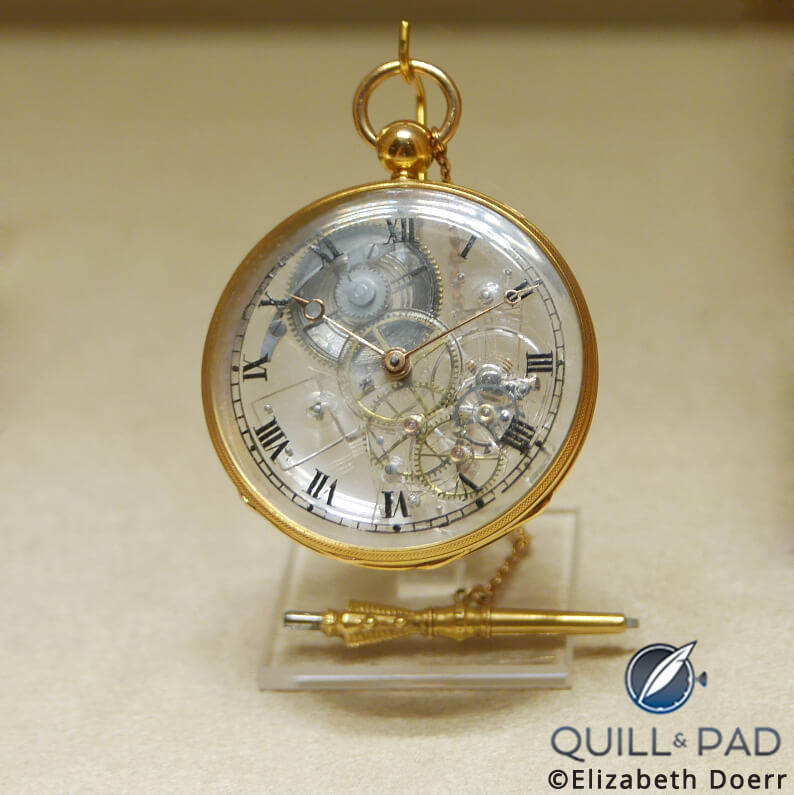
The Crystalline, a pocket watch from about 1850, on display at the 2017 Patek Philippe Art of Watches Grand Exhibition in New York
Unlike today’s technology, where transparent parts of a watch are crafted in synthetic sapphire crystal, composite resin, or plastic using machines, antique watchmakers only had one solution for making movement components see-through: hewing rock crystal, a colorless and clear quartz mineral.
The effect of its use on this pocket watch from about 1850 normally at home in Geneva’s Patek Philippe Museum is mesmerizing.
Quick Facts The Crystalline
Case: 49 x 36 x 10 mm, engine-turned yellow gold with crystal
Movement: key-wound Swiss caliber with main plate and bridges in rock crystal
Functions: hours, minutes
The Little Holy Family
This exquisite heart-shaped pendant watch from about 1675 conceals a delicacy on the back: a miniature enamel painting depicting The Little Holy Family by Giulio Romano.
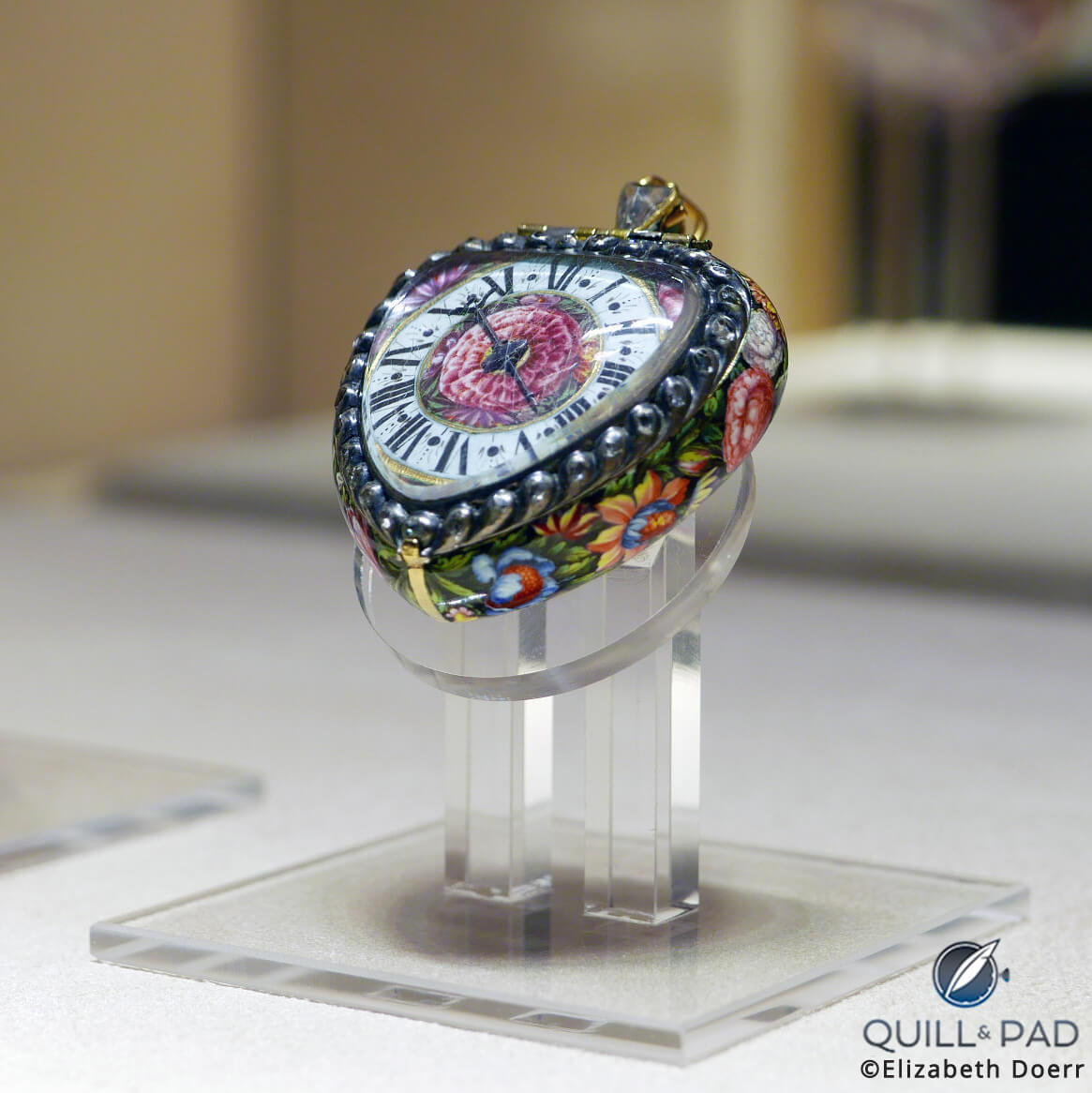
Front of the antique ‘Little Holy Family’ pocket watch from the 2017 Patek Philippe Art of Watches Grand Exhibition in New York
While the enamel artist is unfortunately unknown, the maker of the watch’s movement outfitted with a chain and fusée and verge escapement is known: Johann Martin (also known as Johannes Martinus) from Augsburg, Germany (1642-1721).
It was the arresting visuals of the front of this timepiece that caught my attention, but it was the ancient mechanics squeezed into such a tiny, tiny space that kept me rapt.
Quick Facts The Little Holy Family
Case: 33 x 42 x 15 mm, yellow gold and silver with enamel and diamonds
Dial: enamel over copper
Movement: key-wound Johann Martin caliber, fusée and chain, verge escapement
Functions: hours
The Almond
I truthfully don’t know how the unknown maker of this ring watch’s movement was able to put a repeater into this minuscule size: it’s mind-boggling.
In Give Me Five! Rare And Unusual Ring Watches, I profiled six tiny timepieces worn on the finger like a ring, five of which are vintage (yes, I cheated on the number in the headline). But none of those included a repeater, even if one of them was designed just like a pocket watch (you’ll just have to look at the post to see what I mean).
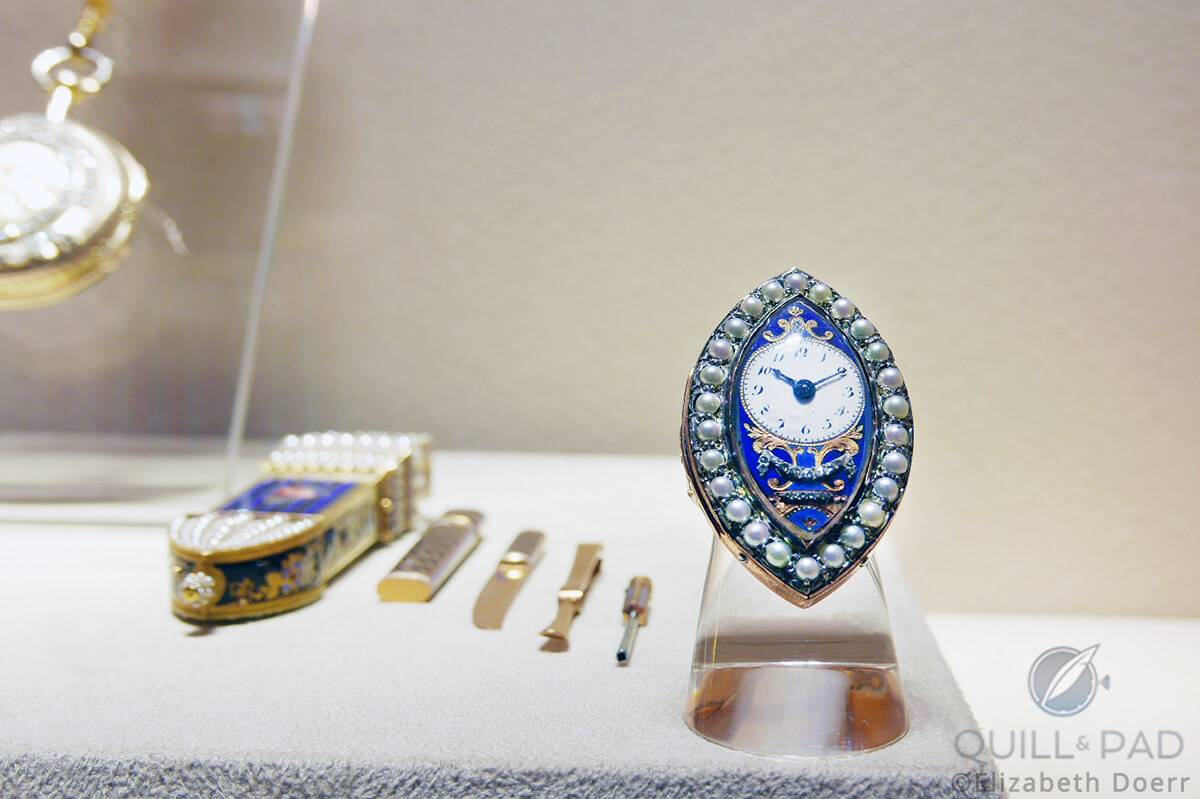
The Almond, a miniature minute repeater inside a ring watch on display at the 2017 Patek Philippe Art of Watches Grand Exhibition in New York
This Almond timepiece from the Patek Philippe Museum in Geneva was made in that creative city around 1800. Oh, the ingenuity!
Quick Facts The Almond
Case: 26 x 42 x 12 mm, yellow gold with champlevé enamel, diamonds, and pearls
Dial: white enamel
Movement: key-wound Swiss caliber, cylinder escapement
Functions: hours, minutes, seconds; quarter repeater on one gong
The Butterfly
This is truly a multi-functional timepiece! The gorgeous butterfly is not only a timekeeper with separate dials for hours/minutes and seconds, but also a snuff box and a music box with automaton, both activated on demand.
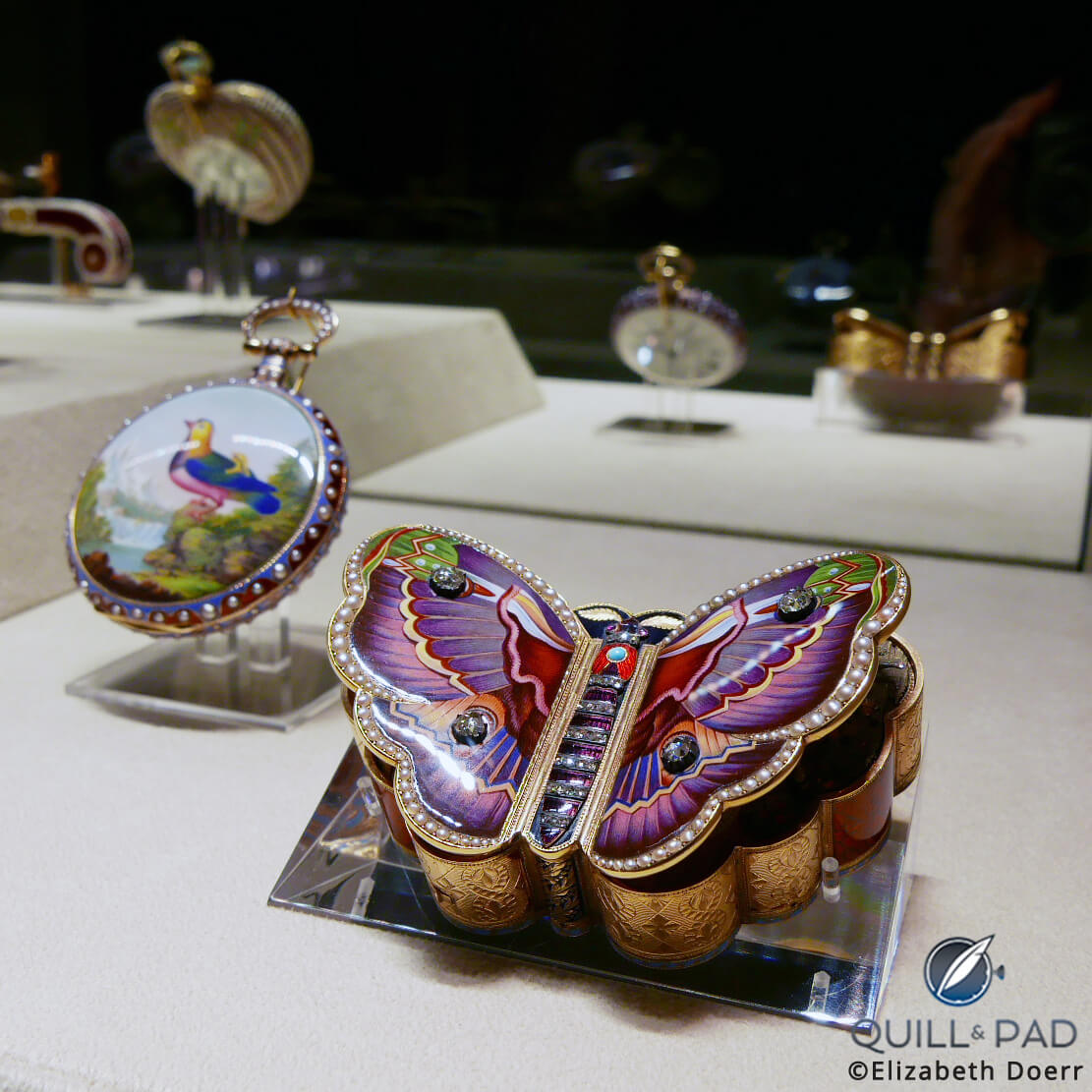
The Butterfly, on display at the 2017 Patek Philippe Art of Watches Grand Exhibition in New York, not only tells the time, but is also a snuff box and a music box with an automaton
Made for the Chinese market in about 1820, its automaton displays a man playing the lyre and a woman playing the mandolin to the sound of the music box. Truly entertaining!
Quick Facts The Butterfly
Case: 84 x 51 x 21 mm, yellow gold with champlevé enamel, turquoise, rubies, diamonds, and pearls
Dial: white enamel (not visible in this photo)
Movement: key-wound Piguet Meylan caliber with twin spring barrels (one for the movement, one for the automaton and music box), cylinder escapement
Functions: hours, minutes, seconds; automaton, music box
Venus Binding Cupid’s Wings
This heart-shaped repeating pocket watch, which belongs to a set of two originally made for the Chinese market, is doubly precious with its movement made by Piguet & Meylan in approximately 1815 and its miniature enamel painting on a gold case back by Jean-Abraham Lissognol.
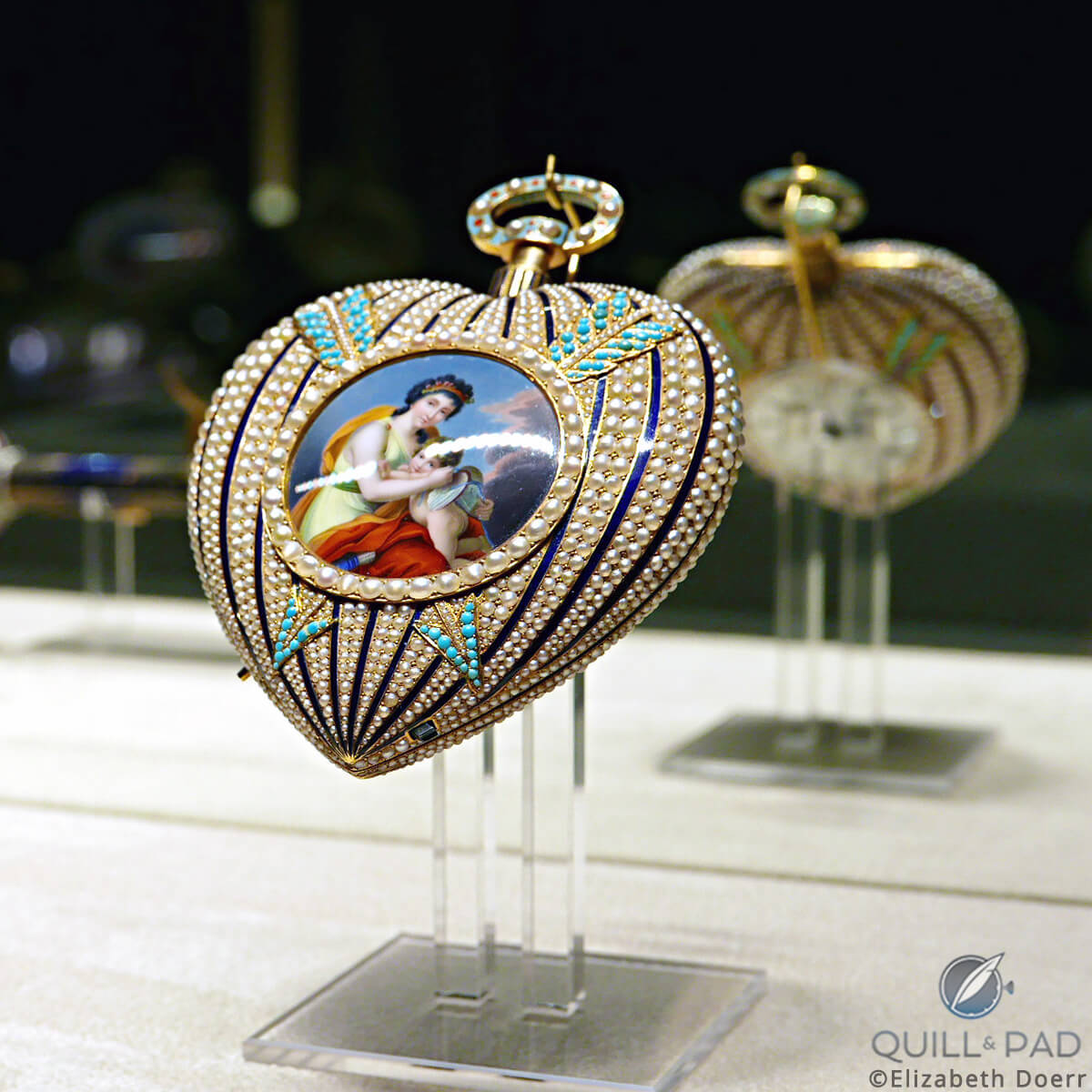
‘Venus Binding Cupid’s Wings,’ a bejeweled repeating pocket watch on display at the 2017 Patek Philippe Art of Watches Grand Exhibition in New York
As was the style in those days, Lissognol recaptured a famous painting in miniature enamel, this one called Venus Binding Cupid’s Wings by Louise-Elisabeth Vigée-Lebrun, an artist who also very famously also painted Marie Antoinette (see Let Them Eat Cake: The Intriguing Story Of Marie Antoinette And Her Legendary Breguet Pocket Watch No. 160 for a photo of that painting, which hangs at Versailles’ Petit Trianon).
This exquisite piece caught my attention and my heart when I saw it at the exhibition. Its mate, not shown, also includes a music box and an automaton that depicts a couple playing a mandolin and a harmonica.
Quick Facts Venus Binding Cupid’s Wings
Case: 66 x 90 x 24 mm, yellow gold with enamel, turquoise, and pearls
Dial: white enamel
Movement: key-wound Piguet Meylan caliber with twin spring barrels (one for the movement, one for the repeater), cylinder escapement
Functions: hours, minutes, seconds; quarter repeater on two gongs
You might also enjoy:
- Give Me Five! 5 American-Themed Rare Handcraft Watches At Patek Philippe’s 2017 Art Of Watches Grand Exhibition In New York
- Give Me Five! 5 Unanticipated Exhibits At Patek Philippe’s Art Of Watches Grand Exhibition In New York
- You Are There: Patek Philippe (And Virtually Everyone Else) Comes To New York, A Collector’s View
- Patek Philippe President USA Larry Pettinelli Talks His Favorite Timepiece In The 2017 Grand Exhibition: John F. Kennedy’s Clock
- Quite Possibly The Largest Curated Assembly Of Vintage Patek Philippe Watches For Sale In History At Christie’s New York: It’s An 11-Day Sale, But Don’t Dally!
- Bringing Patek Philippe’s Universe To New York City For 11 Days In July With ‘The Art Of Watches Grand Exhibition’
Leave a Reply
Want to join the discussion?Feel free to contribute!





















































The Crystalline!
I know right!
How about the one with Moses parting the Red Sea? On activation, the sea waves were animated. It was quite special.
The art of watchmaking in it’s purest form, at a time when there was no electricity, no websites.
Respect to thoose artists at that time.
The utmost respect! There are hardly more delightful items on the planet, and kudos to Patek Philippe for helping preserve the ones that are still in existence.